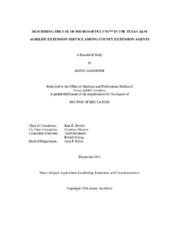| dc.description.abstract | The purpose of this study was to describe the use and acceptance of Microsoft® Lync™ among agents from the Texas A&M AgriLife Extension Service. A survey research design was used with an on-line questionnaire containing 23 items. The questionnaire was modified from the Unified Theory of Acceptance and Use of Technology (UTAUT) model and found to be a reliable and valid instrument. The UTAUT scale was developed by Venkatesh, Morris, Davis & Davis (2003) to assess users’ technology preferences. Constructs examined in this study were performance expectancy, effort expectancy, and self-efficacy.
Six-hundred-thirty-six county Extension agents employed during January 2014 participated in the study. The survey instrument was administered on-line using Qualtrics® On-line Surveys. According to the Qualtrics data, there were 340 respondents yielding a response rate of 53% with a dropout rate of 2%. Descriptive statistics (mean and standard deviation) were run on the performance expectancy, effort expectancy, and self-efficacy constructs to determine county Extension Agents’ agreement of usage and acceptance of Microsoft® Lync™. Demographics collected during the Microsoft® Lync™ study were used to determine if there were significant differences of means. These personal characteristic variables included gender, Extension region, Extension program area, Extension experience, and size of county population.
Significant differences based upon gender and program area. Females composed a larger portion of the sample at 54% and scored significantly higher on a number of questions. The second demographic value that demonstrated significant differences were the program areas of 4-H and Youth Development, Family and Consumer Sciences, Horticulture, and Agriculture and Natural Resource. Essentially, 4-H agents had significantly higher means on items regarding Lync™ usage. Mean, standard deviation, and t-tests/ANOVA were used for this portion of the survey results. Performance expectancy earned a reliability coefficient of .92 and effort expectancy of .91 in this study. Thus, the internal consistency of performance expectancy, effort expectancy, and self-efficacy was reliable (Cronbach, 1951) and deemed sufficient in order to address the study’s research objectives. As a result, Microsoft® Lync™ has proven to be an effective communication and collaboration tool for the Texas A&M AgriLife Extension Service. | en |


